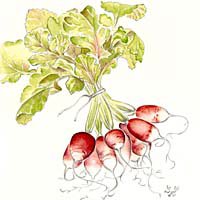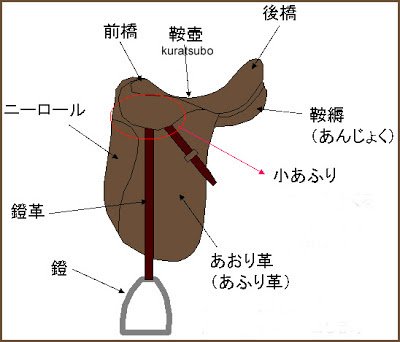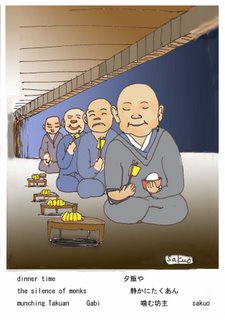:::::::::::::::::::::::::::::::::::::::::::::::::::::::::::::::::::::::::::::::::::::::::::::::::::::
。。。 RAIN - AME - 雨
***** Location: Worldwide
***** Season: Various seasons, see below
***** Category: Heavens
*****************************
Explanation

"Okutama in the rain" - Kawase Hasui 川瀬 巴水 (1883-1957)
The word RAIN just like that (ame 雨) is not a kigo in Japan.
Expressions like "long rain, strong rain, gentle rain, soft rain, steady rain" without the mentioning of a specific season are also NOT considerd kigo but topics.
"sheets of rain" can be seen during any strong rain on our windows. This expression is also not a kigo.
Raindrops, again no kigo by itself.
But since the rain in a constant partner throughout the year, there are many kigo connected with it.
A friend suggested there are more than 400 kigo connected to the rain.
Quite possible.
We have the rainy season and the typhoons with a lot of damage, we have flooding and rain rituals.
For the farmers of the Edo period, proper rainfall was a matter of life and death, because it affected the rice harvest.
Rain was called the "Water of Heaven", tensui 天水.
Strong emotions are attached to some kinds of rain:
spring drizzle (harusame) leads to romance -
long summer rain (samidare) makes us melancholic -
cold showers in autumn and winter (shigure) show the uncertainty of all things.
Let us go through the seasons in more detail.
Gabi Greve
:::::::::::::::::::::::::::::::::::::::::::::::::::::::::::::::::::::::::::::::::::::::::::::::::::::
ama-dare no .......... 雨だれの
ootsubu kotsubu .......... 大粒小粒
sugi no eda .......... 杉の枝

dripping rain
in big drops, small drops –
a cedar branch
Regen -
grosse Tropfen, kleine Tropfen
vom Zedernast
Gabi Greve (Photo from Tanjoo-ji Temple, Japan)
:::::::::::::::::::::::::::::::::::::::::::::::::::::::::::::::::::::::::::::::::::::::::::::::::::::
quote
Traces of Dreams - Haruo Shirane
... Harusame (spring rain) referred to the soft, steady drizzle of spring; samidare (literally, rains of the Fifth lunar Month) meant the wet season or the extended rains of summer; and shigure signified the brief, intermittent showers of early winter.
In the poetic tradition these became seasonal topics with specific poetic associations, which were derived from classical precedent and commonly recognized as the most appropriate subjects of composition.
... Spring rain, for example, became associated with soft, dreamy thoughts; the wet season, particularly that of the Fifth Month, implied a sense of unending depression; and the intermittent showers of winter connoted impermanence and uncertainty.
These poetic topics and their associations are, in a fundamental sense, imaginary worlds, which join the poet and the reader, and represent a communal, shared imagination. In writing about the scattering of the cherry blossoms, the Japanese poet is not just writing about a specific, direct experience; he or she is writing a supplement to or a variation on a commonly shared body of poetic associations with respect to the seasons, nature, and famous places based on centuries of poetic practice.
Here, as in the allusive variation (honkadori), originality or individuality is not the touchstone of literary genius, as it often is in the Western tradition. Instead, high value is given to the ability to rework existing subject matter.
source : books.google.co.jp
:::::::::::::::::::::::::::::::::::::::::::::::::::::::::::::::::::::::::::::::::::::::::::::::::::::

"Harema" 晴れ間 Lull in The Rain
Katsuyuki Nishijima (b.1945), - 1988.
:::::::::::::::::::::::::::::::::::::::::::::::::::::::::::::::::::::::::::::::::::::::::::::::::::::
SPRING
rain in spring (haru no ame 春の雨)
that could be any kind of rain, usually an unpleasant cold one, during springtime.
spring-rain, spring rain (harusame 春雨)
harusame is the word for Chinese glassnoodles. This is a kind of soft, welcome rain for the rice paddies and fields which are dry from the winter time. It is a gentle rain that can last for a day or longer.
Some famous SPRING RAIN haiku
Umbrella for spring rain, harusame gasa 春雨傘(はるさめがさ)
evening shower in spring, haru yuudachi
春夕立(はるゆうだち)
..... haru shuu-u 春驟雨 (はるしゅうう),
..... haru no shuu-u 春の驟雨(はるのしゅうう)、
("afternoon showers" , just like that, is a topic for haiku.)
long spring rain, haru no naga-ame, 春の長雨(はるのながあめ)
..... haru rin-u 春霖雨(はるりんう), shunrin 春霖 (しゅんりん)
(haru no nagame 春の長雨 can be used in classical poetry)
"brings the trees to bud", konome moyashi 木の芽萌やし(このめもやし)
gentle rain at the time when trees start to bud.
rain on the cherry blossoms (hana no ame 花の雨)
Either rain directly on the cherry blossoms themselves or
rain during the time of cherry blossoms (hanadoki no ame 花時の雨)
According to the Nihon Kokugo Daijiten, it can also be a metaphor (mitate) for a heavy fall of blossoms/petals. (In this case, petals falling like snow (hanafubuki) can also be used.
This chilly rain evokes a feelilng of sadness of course, since the blossoms are to go. In older haiku and tanka, it had the atmosphere of FUGA 風雅. Lately, it is more of the cumbersome variety of viewing cherry blossoms in a crowd with umbrellas and rain splashing on your legs from too much traffic on the road ...
"Rain on Blossoms" (hana no ame) 花の雨
rain during the time of cherry blossoms, hanadoki no ame
花時の雨(はなどきのあめ)
fuuga
rain on the rape flowers, natane zuyu, 菜種梅雨 (なたねづゆ)
sleet in spring, haru shigure 春時雨 (はるしぐれ)
... haru no shigure 春の時雨(はるのしぐれ)
april shower, april showers
quote
April showers is a term that denotes spring rains in some parts of the northern hemisphere, in particular the UK, during the Gregorian or Julian month of April. One of the major reasons for the, often, very heavy showers and downpours that characterise April is the position of the jet stream.
In early spring the jet stream starts to move northwards allowing large depressions to bring strong winds and rain in from the Atlantic and in one day the weather can change from springtime sunshine to winter sleet and snow. The track of these depressions can often be across Ireland and Scotland bringing bands of rain followed by heavy showers (often of hail or snow) and strong blustery winds. So in one day the weather can change from springtime sunshine to winter sleet and snow.
© More in the WIKIPEDIA !
:::::::::::::::::::::::::::::::::::::::::::::::::::::::::::::::::::::::::::::::::::::::::::::::::::::

Country town on a rainy night
Saito (Nishimura) Hodo (act. 1930s)
:::::::::::::::::::::::::::::::::::::::::::::::::::::::::::::::::::::::::::::::::::::::::::::::::::::
SUMMER
summer rain, natsu no ame 夏の雨 (なつのあめ)
..... natsusame 夏雨(なつさめ)
"rain on the green", ryoku-u 緑雨(りょくう)
rain in the fifth lunar month 五月雨 samidare
according to the old lunar calendar. Now it refers mostly to the rain during the Rainy Season (from mid-june to mid-july).
persistent summer rain, early summer rain, June rain,
. Samidare - Haiku by Matsuo Basho 松尾芭蕉 - .
rain in the month of satsuki, satsuki ame 五月雨(さつきあめ)
raining in the fifth lunar month, samidaruru さみだるる
rainclouds in the fifth lunar month, samidare gumo 五月雨雲(さみだれぐも)
umbrella for the rain in the fifth lunar month, samidare gasa
五月雨傘(さみだれがさ)
samidare can bee seen as a pun with midare 乱れる, fall into disorder; be disarranged, to be troubled, to feel depressed during the long rainy season.
from the Kokin Wakashu poetry collection Summer 153
Ki no Tomonori 紀友則
五月雨に物思ひをれば郭公
夜深く鳴きていづち行くらむ
samidare ni mono omoi oreba hototogisu
yo fukaku nakite izuchi yukuramu
While I sit brooding
through a midsummer shower,
a cuckoo cries out
in the deepening night --
but which way is he passing?
Tr. Inhammer
.................................................................................

.. .. .. .. may rain
.. .. .. .. leaves dancing
.. .. .. .. in the forest mist
Gabi Greve (Photo from Koya San, Japan)
rain on new leaves (wakaba ame 若葉雨)
rain on green leaves, aoba ame 青葉雨
. murasame 村雨 (むらさめ) "rain on the village"
a passing shower, that brings a special sound to a village with thatched-roof homes.
a kind of yuudachi 夕立, evening shower.
Murasame, name of a Japanese destroyer (1937–1943) of the Imperial Japanese Navy.
"rain to know the time", toki shiru ame 時知る雨 (ときしるあめ)
gentle rain, where you can walk on with your arm lifted over the head and do not need an umbrella yet. Rain that will stop as soon as it started.
..... "fast rain", haya ame 早雨 (はやさめ )
..... "passing rain", toori ame 通り雨 (とうりあめ)
..... "three bundles" rain, mitsuka ame 三束雨 (みつかあめ)
After a thunderstorm, when you have the time to bind three bundles of cut rice plants together before the next rain starts.
tofu-dregs getting rotten (u no hana kutashi (kudashi) 卯の花腐し
again the rain in the old lunar month of may, when it gets hot and warm and the tofu starts rotting soon. During the old lunar month of april and may, the rain was very long (but not yet the rainy season).
Evening Rain at Atake, by Hiroshige
http://www.bc.edu/bc_org/avp/cas/fnart/amico/images-disabled/japan/japonisme.html
Cloudburst, Evening Shower (yuudachi) (夕立):
often connected with a thunderstorm in the evening.
shuuu, shuu-u 驟雨 しゅうう sudden shower, cloudburst
. . . and folks have to run for the washing . . .

鈴木晴信 Suzuki Harunobu (1725 - 1770)
.................................................................................
kigo for late summer
kiu, ki-u 喜雨 (きう) "beneficial rain"
..... jiu, ji-u 慈雨(じう)
ame yorokobi 雨喜び(あめよろこび)to be happy about the rain
After a long draft in summer, this was the first rain, welcomed by the farmers and their prached fields.
. Rain Rituals (amagoi)
prayers for rain during a drought
prayers for too much rain to stop
. Flood, flooding (koozui 洪水) .
----- demizu 出水
with kigo for all seasons
. Flood prevetnion .
.................................................................................
rainy season (tsuyu, bai-u 梅雨)
literally "ume no ame", the rain on the plums. The plums (or rather apricots) are just getting ready to be picked and pickled to make salt-plums, umeboshi. Some haiku books quote the rainy season as a season in itself.
..... See here: Rainy Season (tsuyu) Japan
forebodes of the rainy season (hashiri-zuyu 走り梅雨) : rain during the end of may (old lunar calendar), before the real onslaught of the rainy season.
ending rain of the rainy season (okuri-zuyu, okuri bai-u 送り梅雨) : usually a real strong downpour to signal the end of the rainy season. I remember one of these endless rains when we had a lot of mudslides and overflown rivers with so much damage all over Japan.
.................................................................................
"great rain", heavy rainfall, downpour (oo-ame, ooame 大雨)
most feared by the farmers because it brings a huge amount of water in a short time and thus a lot of uncontrollable damage.
There are strong rainfalls in other seasons, but they are most typical for the rainy season.
. cool rain, ryoou ryoo-u 涼雨
.. .. .. .. ..
spell of sunshine during a rain (kitsune no yome-iri 狐の嫁入り)
literally: The Fox is taking his bride home. A fox-wedding party) .
- quote -
Kitsune no Yomeiri in Literature
The Meiji period Tanka poet Masaoka Shiki wrote:
“When rain falls from a blue sky,
in the Hour of the Horse,
the Great Fox King takes his bride.”

While Kitsune no Yomeiri is the most common term, there are regional versions of the same phenomenon. In Saitama and Ishikawa prefectures it is known as Kitsune no Yomitori (狐の嫁取り; The Taking of a Fox Bride). In Shizuoka it is called Kitsune no Shugen (狐の祝言; The Fox Wedding Celebration).
In Tokushima, the Kitsune no Yomeiri is a less happy occasion. It was called the Kitsune no Soshiki (狐の葬儀; Fox Funeral) and seeing one is considered an omen of death.
- Read the details :
- source : hyakumonogatari.com - Zack Davisson
short spell of rain, almost like the "fox rain"
sobae ame, sobae 日照雨 (そばえあめ)
"rain and shine", tenki ame, 天気雨 (てんきあめ)
. kitsune no yome-iri, kitsune no yomeiri
狐の嫁入り "the fox taking a bride" .
in Japanese art, festivals and legends
:::::::::::::::::::::::::::::::::::::::::::::::::::::::::::::::::::::::::::::::::::::::::::::::::::::
AUTUMN
autumn rain, aki no ame, 秋の雨 (あきのあめ)
... akisame 秋雨(あきさめ)
... shuurinn 秋霖(しゅうりん), aki tsuiri 秋黴雨(あきついり)
autumn rain front, akisame sensen 秋雨前線

Autumn Rain Front, September 2006, Japan
long rain of autumn (aki no naga-ame 秋の長雨)
sometimes equivalent to the rainy season in its power.
autumn-rain (shuurin 秋霖 )
refers to the long rain of autumn.
susuki baiu, bai-u すすき梅雨 "rainy season on the pampas grass"
sleet in autumn, aki shigure 秋時雨 (あきしぐれ)
kigo for early autumn
"washing the mountain", oyama arai 御山洗 (おやまあらい)
Fuji no yama-arai 富士の山洗(ふじのやまあらい)washing mount Fuji
Strong rain in autumn, that clears the mountain air.
. tanabata ame 七夕雨(たなばたあめ)
rain on the Tanabata star festival day .
.................................................................................
La pluie d'automne
Autumn rain haiku by Richard Vallance
... ... ...
Ploi mocăneşti / slow-dripping rain in Romania
slow-dripping rain falls
on the asphalt, grey on grey,
on my soul as well…
Oaspete prelung—
o ploaie mocănească
nici un alt prieten
a long staying guest—
a slow-dripping rain
no other friend
câinele nervos:
a adormit chiar şi el:
ploi mocăneşti
the furious dog
yes, even he fell asleep:
long, slow-dripping rains
Cristian Mocanu
:::::::::::::::::::::::::::::::::::::::::::::::::::::::::::::::::::::::::::::::::::::::::::::::::::::
WINTER
Rain in winter, fuyu no ame
冬の雨 (ふゆのあめ)
Winter drizzle (shigure) 時雨 rain mixed with snow, cold rain, snowy drizzle, sleet
..... Including many kigo with this connection. !!!!!
ice-rain, hi-same 氷雨 : rain with icepieces, sort of hail.
rain in the cold , kan no ame 寒の雨 (かんのあめ)
..... kanku no ame 寒九の雨(かんくのあめ)
:::::::::::::::::::::::::::::::::::::::::::::::::::::::::::::::::::::::::::::::::::::::::::::::::::::
NEW YEAR
rain on January 1, onburi 御降り (おんふり)
"honorable downpour".
If it rains, the harvest will be blessed in this year.
..... o-sagari おさがり
:::::::::::::::::::::::::::::::::::::::::::::::::::::::::::::::::::::::::::::::::::::::::::::::::::::
Rain as an all-season topic
fragrance of rain, ame no ka 雨の香
ame no ka ni tachimasarikeri matsu no shin
fragrance of rain -
growing up eagerly,
the pine candles
Watanabe Suiha (1882 - 1946)
.......................................................................
amayadori 雨宿り taking shelter from the rain
雨宿り額の文字をよく覚え
amayadori gaku no moji o yoku oboe
taking shelter from the rain
I begin to remember the writing
of the temple name plate

If you have to stand under the eaves of a temple and wait for the rain to stop, eventually looking up, seeing the name plate, you will remember it. This shows the time that has passed during a long shower.
- - - - -
本ぶりに 成て出て行 雨やとり
honburi ni natte deteyuku amayadori
he left only
after it rained really hard and then
had to take shelter from the rain
This implies a person who waits too long to start something important, and then gets into trouble.
- - - - -
いりもせぬ物の値をきく雨宿り
iri mo senu mono no ne o kiku amayadori
asking for the price
of something he does not intend to buy -
taking shelter from the rain
If you have to stand under the eaves of a shop for a long time, you might as well pretend you are interested in buying something.
- - - - -
俄雨思い思いに化けて行き
niwaka ame omoi-omoi ni bakete yuki
sudden rainfall -
all kinds of things take shape
and run along
People make use of what they have to protect themselves from the rain, if they have no umbrella. For example a furoshiki wrapping cloth, the apron of a woman, a straw sack for rice or anything will do.
- - - - -
俄雨瀬戸物売りは常の足
. niwaka ame setomono uri wa tsune no ashi .
the vendor of pottery
牛方のあきらめて行く俄雨
. ushikata no akiramete yuku niwaka ame .
. senryu, senryū 川柳 Senryu in Edo .
俄雨帰って聞けば降りませぬ - it rains only in some parts
俄雨女がいいと傘がふり
俄雨昼寝の上へほうりこみ - leaves the washing outside
俄雨添乳に亭主遣うわれる
俄雨恨みを言って貸してやり -
*****************************
Worldwide use

"Paris Street" (1875) by Gustave Caillebotte (1848-1894)
:::::::::::::::::::::::::::::::::::::::::::::::::::::::::::::::::::::::::::::::::::::::::::::::::::::
India Saijiki
Rain and Haiku
.. .. .. Monsoon, the Rains (July - August)
:::::::::::::::::::::::::::::::::::::::::::::::::::::::::::::::::::::::::::::::::::::::::::::::::::::
Florida, Texas and other areas of North America
"iron rain"
a very strong rain that falls in summer, but feels cold, like iron pellets.
*****************************
Things found on the way
Book about the heavenly and earthly phenomenon in Haiku
Haiku no Tenchi

Tsuji Momoko
ISBN4-422-73120-3
:::::::::::::::::::::::::::::::::::::::::::::::::::::::::::::::::::::::::::::::::::::::::::::::::::::
Two Raindrops (A Fable)
Two little raindrops were born in a shower,
And one was so pompously proud of his power,
snip snip
At last it came to its journey's end,
And welcomed the sea as an old-time friend.
"An ocean," it said, "there could not be
Except for the millions of drops like me."
Read it all HERE:
source : www.apples4theteacher.com . Joseph Morris
:::::::::::::::::::::::::::::::::::::::::::::::::::::::::::::::::::::::::::::::::::::::::::::::::::::
amadare あまだれ - 雨だれ - 雨垂れ
raindrops falling from the eaves or leaves
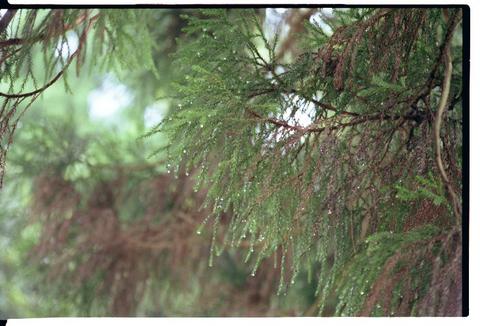
. WKD : amadare haiku .
雨だれや三粒おちてもけさの秋
amadare ya san tsubu ochite mo kesa no aki
raindrops --
only three
but fall's here
Tr. Chris Drake
This humorous hokku was written on 7/1 (August 5) in 1804, when Issa was traveling around the area east of Edo. Issa notes in his diary that the official beginning of lunar autumn that year was on 7/2. Perhaps Issa read the hokku to his hosts the next morning, the first day of autumn.
The word amadare in the first line can mean
1) rain dripping from the eaves of a building, from a tree limb, from an umbrella, from a wide rush hat, etc. or
2) simply raindrops (ame-shizuku, uteki).
In the hokku there is no direct indication of what kind of raindrops Issa sees, hears, or feels on his head. Since Issa was traveling around, he could have felt the drops hit him as he walked, or he could been inside, sitting near a porch somewhere. What interests Issa is that only three drops fall. Autumn, especially late autumn, is a season with a lot of cool and increasingly cold showers, so the first morning of autumn only barely manages to live up to its reputation of being a fall-like day. Like so many other things in life which only barely manage to be what they're supposed to be.
Chris Drake
. WKD : Kobayashi Issa 小林一茶 in Edo .
*****************************
HAIKU
Oku no Hosomichi - 奥の細道 - おくのほそ道
. - - - Station 28 - Mogamigawa 最上川 - - - .
Matsuo Basho on the road in Tohoku:
五月雨を集めてはやし最上川
samidare o atsumete hayashi Mogamigawa
collecting the June-rain
running so fast -
the river Mogamigawa
Tr. Gabi Greve
Gathering the rains of summer,
how swift it is -
Mogami-gawa River
By gathering water from samidare,
Mogami-gawa River flows
very quickly
source : ejje.weblio.jp
The Mogami River,
gathering rain of May
and even more rapid
Tr. Wikipedia, Mogami River
Swiftly flowing Mogami River !
All water is from
early summer rain
source : www.travel-around-japan.com
. . . . .
春雨や 蜂の巣つたふ 屋根の漏り
harusame ya hachi no su tsutau yane no mori
spring rain -
drips from a wasp's nest
through the leeking roof
Matsuo Basho
Tr. Gabi Greve
MORE in the WKD Archives :
. Samidare haiku by Matsuo Basho 松尾芭蕉 .
:::::::::::::::::::::::::::::::::::::::::::::::::::::::::::::::::::::::::::::::::::::::::::::::::::::::
- - - - - - Yosa Buson and akisame 秋雨 - - - - -
秋雨や水底の草を踏み渡る
akisame ya mizusoko no kusa o fumaretaru
rain in autumn -
I step on the grass in the water
to cross (the river)
秋雨や我菅簑はまだ濡らさじ
akisame ya waga sugemino wa mada nurasaji
rain in autumn -
my straw raincoat
not yet wet
. mino 蓑/簑 straw raincoat .
. Yosa Buson 与謝蕪村 in Edo .
:::::::::::::::::::::::::::::::::::::::::::::::::::::::::::::::::::::::::::::::::::::::::::::::::::::::
鳩の恋烏の恋や春の雨
hato no koi karasu no koi ya haru no ame
pigeons mating
crows mating -
rain in spring
Kobayashi Issa
Tr. Gabi Greve
:::::::::::::::::::::::::::::::::::::::::::::::::::::::::::::::::::::::::::::::::::::::::::::::::::::::
秋時雨今日も駅まで同じ道
aki shigure kyoo mo eki made onaji michi

cold autumn rain -
today again
the same way to the station
(Tr. Gabi Greve)
http://www.cripep.com/tdtv/archives/2004/10/post_308.html
by Katsumi 勝美
xxxxxxxxxxxxxxxxxxxxxxxxxxxxxxxxxxxxx
two monks
no other master
than the rain
beggarly pilgrims
walking in the rain
fragrant grasses

Geert Verbeke
Read more of Geert's haiku about rain
http://happyhaiku.blogspot.com/2004/01/friends-geert-verbeke.html
xxxxxxxxxxxxxxxxxxxxxxxxxxxxx
autumn rains ~
so many birds in wild song ~
a barking dog
autumn drizzle ~
a crow makes an
aimless traversing
Narayanan Raghunathan, India 2006
:::::::::::::::::::::::::::::::::::::::::::::::::::::::::::::::::::::::::::::::::::::::::::::::::::::
Rain Drops
Slowly sliding down
from one leaf to another,
earth waits patiently.
Minal Sarosh, India, January 2008
:::::::::::::::::::::::::::::::::::::::::::::::::::::::::::::::::::::::::::::::::::::::::::::::::::::
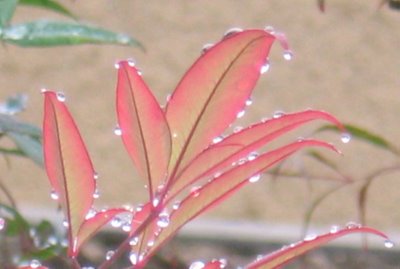
raindrops
in the autumn sun -
a samurai's garden
Treading on God's Gift
" 'How beautiful the rain looks,' thought the Mulla, watching from his window. 'It washes everything clean and makes the flowers and trees grow. It is truly one of the most beautiful signs of God's grace.'
.
'Rain is one of God's great gifts. I can't believe that people try to run away from it.
No wonder God asks in His holy book:
How many of My gifts will you deny?'
. Rain - a Gift of God .
:::::::::::::::::::::::::::::::::::::::::::::::::::::::::::::::::::::::::::::::::::::::::::::::::::::
meeting rains
my umbrella sings
inside a songless me
RAIN FALLING
TREES SINGING
SHOWER BATH SONG
Rajendra Raju Samal, India, June 2009
:::::::::::::::::::::::::::::::::::::::::::::::::::::::::::::::::::::::::::::::::::::::::::::::::::::
from the Kigo Hotline 2010!
cold drops of rain
together with wind
shaking trees
al serban - romania
rain and wind --
i prefer to avoid
roadside trees
Sunil Uniyal-India (New Delhi)
:::::::::::::::::::::::::::::::::::::::::::::::::::::::::::::::::::::::::::::::::::::::::::::::::::::
ever more rain -
I am losing the battle
against the weeds
Gabi Greve
. Sharing a wet July 2012 .
*****************************
Related words
***** Sleet, rain mixed with snow, cold rain, wy drizzle (shigure)
***** Dew, dewdrops (tsuyu) Japan heavy with dew, tsuyukeshi,
***** Cloud, clouds(kumo) Japan, worldwide. Various Kigo.
. SAIJIKI - HEAVEN in all seasons
[ . BACK to DARUMA MUSEUM TOP . ]
[ . BACK to WORLDKIGO . TOP . ]
:::::::::::::::::::::::::::::::::::::::::::::::::::::::::::::::::::::::::::::::::::::::::::::::::::::


